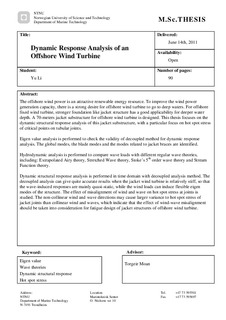| dc.description.abstract | The offshore wind power is an attractive renewable energy resource. To improve the wind power generation capacity, there is a strong desire for offshore wind turbine to go to deep waters. For offshore fixed wind turbine, stronger foundation like jacket structure has a good applicability for deeper water depth. A 70-meters jacket substructure for offshore wind turbine is designed. This thesis focuses on the dynamic structural response analysis of this jacket substructure, with a particular focus on hot spot stress of critical points on tubular joints.
Three types of models are applied for analyses in this thesis. For eigen-value analysis the entire modal including the wind turbine, tubular tower and jacket supporting structure is used in the program USFOS-VPOne. For hydrodynamic analysis the refined substructure model with complete jacket structure and tubular tower is applied in USFOS. The equivalent monopile model is constructed in HAWC2 to predict wind loads.
Eigen value analysis is performed to check the validity of decoupled method for dynamic response analysis. The first eigen period is about 2.9s, far less than the main wave input periods, which implies the wave loads are mainly quasi-static, therefore the simplified decoupled analysis method can be applied. The global modes, the blade modes and the modes related to jacket braces are identified.
Hydrodynamic analysis is performed to compare wave loads with different regular wave theories, including: Extrapolated Airy theory, Stretched Wave theory, Stoke’s 5th order wave theory and Stream Function theory. It is proved that for extreme wave conditions, higher order wave theories such as Stoke’s 5thorder wave theory and Stream Function theory should be applied since linear wave theories will under-estimate the structural reactions.
Dynamic structural response analysis is performed in time domain with decoupled analysis method. The effect of misalignment of wind and wave on hot spot stress at joints is studied. It is observed that wave propagation directions has more significant effects on structural response than wind directions, while wind force has more significant influence on dynamic structural response rather than wave forces no matter in which directions they are propagating. | nb_NO |
